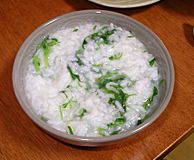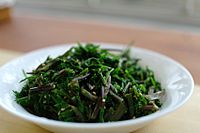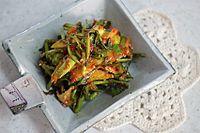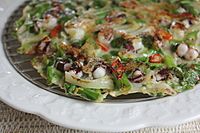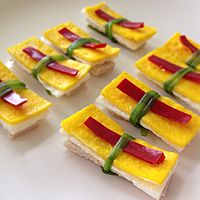Oenanthe javanica facts for kids
Oenanthe javanica, also known as Java waterdropwort or water celery, is a plant that comes from East Asia. People also call it Chinese celery, Indian pennywort, or Japanese (flat leaf) parsley. This plant grows naturally across many parts of Asia and even in Queensland, Australia.
Quick facts for kids Oenanthe javanica |
|
|---|---|
 |
|
| Conservation status | |
| Scientific classification | |
| Genus: |
Oenanthe (plant)
|
| Species: |
javanica
|
| Synonyms | |
|
|
It's important not to confuse Oenanthe javanica with other plants. For example, Cryptotaenia is sometimes called "Japanese wild parsley." Also, Apium graveolens var. secalinum is known as "Chinese celery." There are many plants called "water dropwort" or "water celery," so knowing the scientific name helps.
Contents
What Does Water Celery Look Like?
Oenanthe javanica is a plant that lives for many years. It can grow up to 1 meter (about 3 feet) tall. Its roots are like thin threads and grow from all parts of the stem.
Leaves and Flowers
The plant has small white flowers with five petals. Each flower also has five stamens, which are the parts that hold pollen. The leaves smell nice and are smooth. They have a special part that wraps around the stem. The leaves are also divided into smaller parts and look a bit crinkled.
There is a special type of this plant called 'Flamingo'. Its leaves have pretty pink edges. You can find this plant growing wild in wet places. It likes to be near streams or at the edges of ponds.
Is it Invasive?
In some parts of the United States, this plant is considered an invasive species. This means it can grow very quickly and take over areas. When this happens, it can harm local plants and ecosystems.
How People Use Water Celery
Many plants in the Oenanthe family are very poisonous. But Oenanthe javanica is different. It is safe to eat! People grow this plant in many countries. It is popular in China, India, Japan, Korea, and other Asian countries. It is also grown in Italy. In these places, people enjoy eating its fresh spring shoots as a vegetable.
Water Celery in India
In the northeastern part of India, especially in Manipur, this plant is called komprek (Meitei: ꯀꯣꯝꯄ꯭ꯔꯦꯛ). It is a key ingredient in two popular dishes from Manipuri cuisine. These dishes are called eromba and singju.
Water Celery in Japan
In Japan, the plant is known as seri (セリ). It is an important part of a special dish eaten during a spring festival. This festival is called Nanakusa-no-sekku. The dish is a type of rice porridge with seven herbs.
-
Nanakusa-gayu (seven herb congee) eaten on Nanakusa-no-sekku (seven herb festival)
Water Celery in Korea
Koreans call this plant minari (미나리). They often eat it as a namul vegetable. Namul means seasoned vegetable dishes. You might have heard of the award-winning 2020 movie Minari. The film was named after this very vegetable!
-
Minari-muchim (seasoned water dropwort salad)
-
Minari-oi-muchim (seasoned water dropwort and cucumber salad)
-
Minari-buchimgae (water dropwort pancake)
-
Minari-ganghoe (water dropwort rolls)
See also
 In Spanish: Oenanthe javanica para niños
In Spanish: Oenanthe javanica para niños



